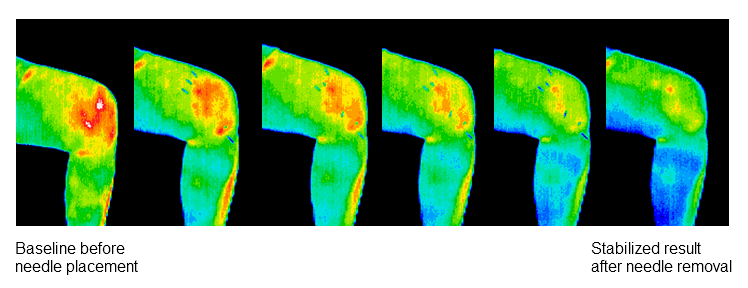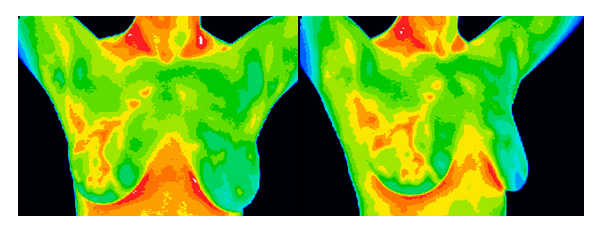Monitoring Effects and Rare Findings

Monitoring Effects of Therapy
Clinician and patient, working together, can use thermal imaging to monitor for improvements in treatment to evaluate for changed/improved thermal patterns.

Sequential recording at 5 minute intervals with needles in place.
Very objective monitoring of the effects of treatment can be recorded. In this comparative study over time, (30 minutes) a significant change in the temperature differentials in the medial left leg is due to the acupuncture treatment. The entire region of interest is seen to cool but the local area of inflammation in the medial knee changes and reduces at a much greater rate.
Incidental and Rare Findings

Thermal imaging is the only tool that can visualize areas of inflammation that indicate unhealthy (possibly dangerous) patterns that require intervention, additional forms of imaging, clinical evaluation, risk assessment, or a combination of any of the above.
Radial scar case study: A radial scar may be caused by breast surgery, or breast inflammation or hormonal changes. It may also be the byproduct of fibrocystic changes (another good reason to reverse fibrocystic changes if detected). Women who are diagnosed with a radial scar have a lifetime risk of developing breast cancer of 150 to 200% greater than average.

Hyperthermia is noted at the hands bilaterally, encompassing a glove-like distribution. This may relate to either diffuse arthritic activity or to autonomic dysfunction. Correlation with diabetes screening as well as rheumatological studies (ESR, ANA and Rheumatoid Factor) can be considered if clinically indicated. (If the ΔT ºC is greater than 4 ºC proximal to distal, it is an indication of autonomic dysfunction and the majority of the time, it is diabetes). There are no significant thermal findings seen in the area on which the pointer is placed.
Imaging the upper extremities are only half the picture. The proper indicator for early indications of diabetes is the loss of normal gradients in hands and feet and full body imaging is inclusive of images from head to toe.
